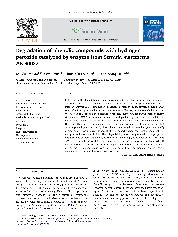摘要
In this paper, the degradation of phenolic compounds using hydrogen peroxide as oxidizer and the enzyme extract from Serratia marcescens AB 90027 as catalyst was reported. With such an enzyme/H2O2 combination treatment, a high chemical oxygen demand (COD) removal efficiency was achieved, e.g., degradation of hydroquinone exceeded 96%. From UV-visible and IR spectra, the degradation mechanisms were judged as a process of phenyl ring cleavage. HPLC analysis shows that in the degradation p-benzoquinone, maleic acid and oxalic acid were formed as intermediates and that they were ultimately converted to CO2 and H2O. With the enzyme/H2O2 treatment, vanillin, hydroquinone, catechol, o-aminophenol, p-aminophenol, phloroglucinol. and p-hydroxybenzaldehyde were readily degraded, whereas the degradation of phenol, salicylic acid, resorcinol, p-cholorophenol and p-nitrophenol were limited. Their degradability was closely related to the properties and positions of their side chain groups. Electron-donating groups, such as -OH, -NH2 and -OCH3 enhanced the degradation, whereas electron-withdrawing groups, such as -NO2, -Cl and -COOH, had a negative effect on the degradation of these compounds in the presence of enzyme/H2O2. Compounds with -OH at ortho and para positions were more readily degraded than those with -OH at meta positions.
- 出版日期2006-9
- 单位合肥工业大学
